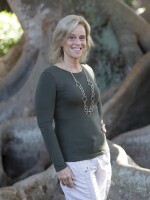Over the course of five days, more than a dozen students and faculty at Ringling College of Art and Design were taught the art and science of facial approximation.
The forensic process involves building a likeness — in clay — of the face of an unidentified person.
"The first two days, we're building the muscular structure of the face, there's no details yet," said Noah Shadowens, a junior at Ringling College.
"But then we paint on the eyes, and it's instantly a little bit shocking. It's, oh, I have remnants of a person now staring into me while I do this."
Like everyone in the workshop, his composition began with a skull replica of an actual unknown person.
But there are very few details about who the victim is.
In Noah's case, all he knows is the person was an Asian man between 18 to 45 years old.

Joe Mullins, a senior forensic imaging specialist who's leading the workshop, admits it's not a lot to go on.
"These are the coldest of the cold cases,” he said. “There's a term that they're categorized in. It's forensically insignificant."
That calculation doesn't take into account that these unknown people were once a son or a daughter.
But Mullins says a mix of art and science can help solve some of these longstanding mysteries.
"I can't even begin to imagine what it's like not knowing what happened to your loved one for 5, 10, 15 years and not having those answers,” he said.
Mullins has worked with the National Center for Missing and Exploited Children for 25 years. And he partners with art schools across the country to train potential recruits.
For the workshop at Ringling College, the forensic specialist worked with the Florida medical examiner office that covers Lee, Hendry and Glades counties.
Twelve skulls from their unidentified death investigations were scanned and replicated with a 3D printer at Ringling College. Two other cases came from a medical examiner's office in New York.

"Getting access to the skull, and that's a weird phone call to make," said Mullins. "It’s hello, my name is Joe Mullins, I'm a forensic artist. Can I have some of your skulls. It’s a lot of ... what?”
But after nearly 10 years of teaching these workshops and solving a number of cases, Mullins has earned a reputation.
During the workshop, several detectives from Lee County stopped by to watch.
Once the replica skulls were made, the art of facial approximation began.
Students learned to build the faces by using a unique set of guidelines — or markers — that measure the approximate thickness of tissue on each part of the skull, along with basic rules of anatomy.
They start adding muscles and following what the skull might tell them about the width of the nose, or the shape of the lips.
By the end of the days-long workshop, student Noah Shadowens says he felt surprisingly emotional.

"I think the more time you spend with the person that you're making; you get attached. This was somebody's family member; I want to try and honor them as much as I can."
At the conclusion of the workshop, the sculptures were photographed and released to the public. They will also be featured on law enforcement websites.
The goal is to generate leads or to spark recognition by someone who knew the person in life.
The mission, Mullins says, is to eventually clear the shelves of medical examiners offices across the country.
"And the ultimate goal is no cold cases, no families frozen in uncertainty and no skull left behind," he said.
Mullins says these missing people were born with a name. And, they deserve to die with one.
The finished sculptures from the forensic workshop will be on display at the Ringling College library beginning Monday, April 8.




